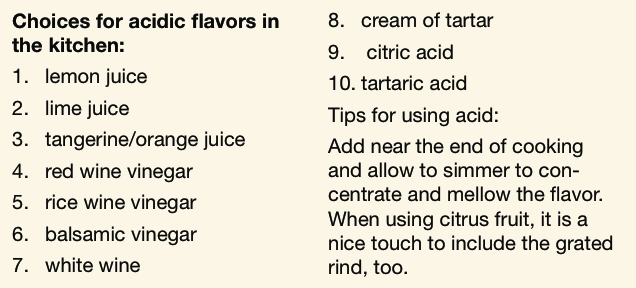Salt Reduction for Cooks
 While there are clear health benefits to reducing our consumption of table salt (i.e. so- dium chloride) doing so and still enjoying our food requires some strategy. This is because table salt, or “sodium chloride”, re- ally does make some foods taste better and it is the only non-toxic substance which, when tasted alone in water, produces a purely salty flavor.1 This is not surpris- ing because we perceive salti- ness through receptors in our mouths that evolved specifically to do so.2 Nevertheless, there are palatable strategies that can help you cut your salt intake.One of them is to enhance salt’s “saltiness” with other tastants. All of the other four flavors, sour, bitter, sweet, and umami, af- fect your ability to taste a given amount of salt, but only one does so in a uniform way; sour.3 Sour flavors result from acids in foods and two common ones are citric and tartaric acids. Citric acid is often used in cooking in the form of lemon juice while tartaric acid can be obtained from wine making suppliers.Many of us like the effect of lemon juice on the taste of fish and wine without tartaric acid isn’t wine. But fewer are aware that these acids can increase the saltiness of sodium chloride. That is, if you add just enough lemon juice to taste its sour flavor, less salt is needed than there would be without the juice. Tartaric acid has a similar effect, but can enhance saltiness in amounts below our ability to detect its sour taste. In cooking, this means you can get the same level of salti- ness with less salt if you add a “tastable” amount of lemon juice or a pinch of cream of tartaric acid. One caution through; the saltiness of sodium chloride also depends on the food in which it is used.How does your pantry score?Give yourself 5 points for each of these items in your pantry:___ canned beans, low sodium___ canned tomatoes, low sodium___ low sodium, low-fat soup___ fruits packed in water___ tuna packed in water___ low sodium veggies___ pasta (+10 if whole grain)___ plain rice (+ 10 if whole grain)___ oatmeal___ barleyDeduct 5 points for each:___ cookies___ sugared cereal___ chips___ rice mix___ pasta mix___ cake mix___ crackersBy Dale E. Vitale, PhD, Chemistry- Physics Dept, Kean UniversityReferences:1. Physiol Behav 66: 27-32, 19992. Prog Biophys Mol Biol 83: 193-225, 20033. Percept Psychophys 57: 18-26, 1995.
While there are clear health benefits to reducing our consumption of table salt (i.e. so- dium chloride) doing so and still enjoying our food requires some strategy. This is because table salt, or “sodium chloride”, re- ally does make some foods taste better and it is the only non-toxic substance which, when tasted alone in water, produces a purely salty flavor.1 This is not surpris- ing because we perceive salti- ness through receptors in our mouths that evolved specifically to do so.2 Nevertheless, there are palatable strategies that can help you cut your salt intake.One of them is to enhance salt’s “saltiness” with other tastants. All of the other four flavors, sour, bitter, sweet, and umami, af- fect your ability to taste a given amount of salt, but only one does so in a uniform way; sour.3 Sour flavors result from acids in foods and two common ones are citric and tartaric acids. Citric acid is often used in cooking in the form of lemon juice while tartaric acid can be obtained from wine making suppliers.Many of us like the effect of lemon juice on the taste of fish and wine without tartaric acid isn’t wine. But fewer are aware that these acids can increase the saltiness of sodium chloride. That is, if you add just enough lemon juice to taste its sour flavor, less salt is needed than there would be without the juice. Tartaric acid has a similar effect, but can enhance saltiness in amounts below our ability to detect its sour taste. In cooking, this means you can get the same level of salti- ness with less salt if you add a “tastable” amount of lemon juice or a pinch of cream of tartaric acid. One caution through; the saltiness of sodium chloride also depends on the food in which it is used.How does your pantry score?Give yourself 5 points for each of these items in your pantry:___ canned beans, low sodium___ canned tomatoes, low sodium___ low sodium, low-fat soup___ fruits packed in water___ tuna packed in water___ low sodium veggies___ pasta (+10 if whole grain)___ plain rice (+ 10 if whole grain)___ oatmeal___ barleyDeduct 5 points for each:___ cookies___ sugared cereal___ chips___ rice mix___ pasta mix___ cake mix___ crackersBy Dale E. Vitale, PhD, Chemistry- Physics Dept, Kean UniversityReferences:1. Physiol Behav 66: 27-32, 19992. Prog Biophys Mol Biol 83: 193-225, 20033. Percept Psychophys 57: 18-26, 1995.


